His brother may be the most famous chef in the world, but Albert has carved out his own kingdom in Barcelona.
Every time Albert Adrià opens his mouth to say something, another plate of food arrives and slams it shut.
We’ve been at a table in his Barcelona tapas restaurant Tickets for 20 minutes and he’s rattled off maybe three complete sentences.
“It seems like a lot, but really we can handle it…”
A plate of potato chips arrives, still hot from the oil, dusted in a burgundy drift of chipotle powder. “The spicy touch is very elegant,” he tells the cook who delivers them. Then he jumps up and follows him back towards the kitchen, putting his hand on his shoulder and whispering secrets about frying temperature and spice distribution into his ear. Finally, he makes his way back to the table.
“The team does everything. I just direct…”
A forest green sphere of olive juice and jalapeño interrupts him. It sits on a perforated spoon, jiggling like a Brazilian Carnival starlet. Albert slides it slowly into his mouth, his eyelids at half-mast. When they open fully again, they’re glazed with disappointment. “Good, but it should be cleaner, more assertive. I want to be in Mexico when I eat it.”
He turns back to me.
“You see, one day I woke up and realized that I wasn’t afraid anymore…”
The last plate looks like a mistake: a small, sad lump of pale flesh bathed in black. Baby squid stuffed with braised veal’s head and sauced with its own ink. He takes a cautious bite, then immediately shovels the rest into his mouth. He closes his eyes, lowers his head and lifts up both of his arms, pinching together his fingers and rolling his wrists like a symphony conductor. He jumps out of his chair and high fives the chef.
“Fuck. Brutal. You nailed it. Make sure you save that for my brother. Yes, please, save that for my brother! He’s coming in tomorrow!”
He sits back down, picks a piece of veal head from his teeth, wipes a squirt of squid ink from his lip, and looks up.
“Where was I? Ah, yes… it’s the metamorphosis concluded.”
If you know anything about Albert Adrià, you know that he is the younger brother of Ferran Adrià. You know this because Ferran is the world’s most famous chef, and because every time Albert has ever been mentioned anywhere, it is always always with these four words dangling around his neck like a leash: el hermano de Ferran.
Don’t believe me? Seven of the first ten results for an Albert Adrià Google search refer to the 43-year-old chef this way.
But talk to chefs and restaurant people around the world and they know Albert not just as the little brother of the most important chef of the past 20 years, but as the brain behind Ferran’s empire, the wizard who helped establish the terms of avant-garde cuisine, and the man as responsible as any other for turning El Bulli into the most influential restaurant of the modern cooking era. Start asking around about Albert and chefs will stand in line to tell you about his brilliance. And the first in line will be Ferran himself.
“He is without a doubt the most complete cook working in the world today.”
When I tell Jose Andrés, who parlayed his El Bulli experience into a 10-restaurant Spanish domain in the States, about Ferran’s opinion of his younger brother, Andrés objects. “Ferran stole that from me. I’ve been saying that for years. Ferran may be an incredible chef, but there is no better cook in the world than Albert.”
The reason Albert is unknown to most people (including pretty much everyone in Spain, where grandmas stop Ferran on the street but Albert remains nearly anonymous) is partly due to the human tendency to heap all praise on one recognizable face rather than give credit to a more opaque team of cooks and collaborators. “Understanding and explaining El Bulli was complicated enough, let alone having to explain not one genius but two,” the great Catalan food critic Pau Arenós once said. Thus, Ferran famously graced the cover of the New York Times Magazine in 2003; thus Ferran was labeled “the greatest chef on the planet” by Joel Robuchon, a man who himself had carried the label of “greatest chef of the century” for years; thus Albert was pegged with an entirely different endorsement, “the greatest unknown cook in the world.”
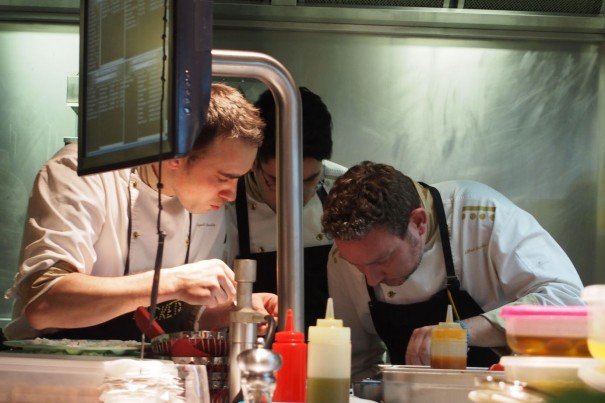
But the other, possibly more powerful deterrent in Albert’s public ascendance is Albert himself, who, deep down is a shy, introverted soul. A few years ago, I spent weeks with Albert in the run up to the opening of Tickets, documenting the progress as part of what would have been a splashy profile on him in the Wall Street Journal Magazine. The idea was something along the lines of “the man behind the man finally gets his due”—a clean and uncomplicated pronouncement of his life beyond El Bulli. Only, a few days before opening, Albert disappeared entirely. Stopped returning phone calls, stopped answering emails. When he surfaced months later, after the restaurant had opened and the story had been shelved, he acted as if nothing had happened. He never mentioned the article.
In 2009, when it was known among the inner sanctum that El Bulli was going to close, Albert left the restaurant and began plotting the next stage of his culinary career. He had opened Inopia, a bustling tapas bar, in Barcelona in 2006, but he left the restaurant three years later and began looking for another place to call home. This time around, he wanted something more permanent. Things happened fast: Tickets, an 80-seat modern tapas restaurant, opened in late 2010, followed shortly thereafter by 41 Degrees, a cocktail bar serving a mixture of classic and highfalutin concoctions, along with a sampling of some of the most famous snacks from El Bulli.
That would be more than enough to keep a man busy and the world well fed in a post-Bulli world, but Albert was still hungry. First, he decided to turn 41 Degrees from a cocktail den into a high-concept tasting extravaganza, with one 16-person, 45-course four-hour feast per night. Then he cooked up the idea for Pakta, a Japanese-Peruvian restaurant with Michelin aspirations and transcontinental tasting menus. Still in the wings are two new projects, the more modest a small spot across the street from Tickets celebrating Catalan vermouth culture, the more ambitious a three-story Mexican restaurant divided into a taqueria, a mezcal bar and an ambitious, tapas-style restaurant serving hyper-stylized regional fare to a few hundred people a night.
“I’m not trying to create an empire or fulfill some kind of egocentric needs. Nothing like that,” he tells me when I float the idea that maybe all this sudden movement might be a perfectly understandable, albeit over-the-top, reaction to spending 25 years in Ferran’s shadow. No, he says, he just sees some holes in the market and he wants to fill them. “If I open five restaurants, it’s because I receive 40 offers.”
Aggressive empire expansion isn’t a new phenomenon in the modern restaurant world. Alain Ducasse owns 25 restaurants across the globe, Joel Robuchon holds 25 Michelin stars across six countries and three continents, and at the current rate of Italian impresario Mario Batali’s expansion, it’s only a matter of time before he opens a mozzarella bar in Pyongyang with Dennis Rodman. What makes Albert different is that this isn’t a brand expansion that spans across continents; he hasn’t deployed an A-team of Spanish chefs to plant the Adrià flag around the world. No, Albert has decided to carve out his kingdom in a few-block radius in Barcelona’s Parallel theater district.
There are other factors that make Albert’s emerging empire unique, as well. The scope of the food being served falls well beyond the Spanish food he built his name on. He is now putting his stamp on high-end Mexican food, on kaiseki-style Japanese cuisine, on spice-charged Peruvian food. These are new and strange waters, even for a guy of his outsize talent. To top it off, he’s making this push in one of the worst economies in Europe, if not the entire developed world. Unemployment in Spain stands at an all-time high of 25 percent (a staggering 40 percent for youth) and GDP is shrinking now at its fastest pace since the recession began. Walk the streets of Barcelona at 2:30 and 9:00 pm, the peak eating hours of the day, and you will find a city full of empty restaurants.
So what does Albert do? He converts a cocktail bar into one of the most ambitious restaurants in Europe, opens up three or four more multi-concept establishments at a head-spinning clip, imports a team of Mexican and Peruvian and Japanese chefs to help him fuse his brand of Spanish modernism with global flavors, and he does it all during the worst economic crisis Spain has seen since the Civil War.
Not a gamble? Not aggressive? Not a “look at me now” moment?
No, he says, as if these ideas never crossed his mind. To Albert, this is a story of a man doing what comes most natural to him: creating food in a way that nobody else ever has.
I remember the first time I experienced the genius of Albert. I was in Arlington, Virginia, staying with a close friend who had spent years in the kitchen working beside him at El Bulli. Before he went to work, he left me a book called Natura, along with a note. “Albert’s a madman. Enjoy.” It took me two hours to get through a bowl of cereal, another 90 minutes to get off the toilet. Later, I brought it to the pool with me, then to a coffee shop and generally spent the day in a state of slack-jawed disbelief. I had never seen anything like it before: translucent flower petals fashioned from crystallized raspberry; a chocolate moon landing with a perfect footprint impressed into the edible lunar surface; jagged candy trees, soils and sands, a hummingbird of elderflower and sesame—the natural world funneled through a feverish LSD dream and turned edible on the other end.
Natura was basically a dynamite stick crammed into a creme brulee, exploding the pastry world into a million little pieces. Desserts didn’t just take new shapes—sponge cakes made in the microwave, liquids fashioned from solids, solids morphed into liquids—but the entire idea of dessert as a uniformly sweet experience suddenly seemed open to interpretation. Talk to any chef about Natura today and they’re likely to close their eyes, bow their heads, and whisper warm, unintelligible things.
What people don’t remember is that Albert arrived to El Bulli just one year after Ferran, a fresh-faced 15 year old with exactly two months’ worth of experience in a Barcelona kitchen. He spent a few years working the seafood station, but because of an allergy to shellfish (a cruel fate for a man who loves seafood above all, but which is mild enough that he still eats whatever he wants), he eventually moved over to pastry, where he set about slowly redefining the idea of dessert.
Those early years, before the entire world was watching their every move, were heady times for the Adrià brothers and young cooks like José Andrés. “Guys who know how to have a good time are always better creators,” says Andrés, “and Albert knows how to have a good time. We would party like there was no tomorrow. Then we’d come back to the kitchen at four in the morning and experiment with things like fried chicken, how to make the skin extra extra crispy. Even in those moments he was figuring things out.”
The radical stuff didn’t come immediately. They still needed to learn the rules before they could break them.

“We had a traditional French-style dessert cart, and it was the best cart in the world at the time, and Albert was behind every one of those desserts,” says Andrés. “I remember a strawberry and kiwi coulis and I’d watch him get it ready—a puree of strawberry, a touch of sugar, a bit of lemon—with a love and a patience I had never seen. One day I asked him, ‘Isn’t this too simple?’ And he said, ‘It’s the simple things that require the most skill.’”
The mathematical precision he brought to the pastry world changed the way the entire kitchen operated as the line between the sweet and savory worlds at El Bulli slowly dissolved. Eventually Albert moved on to be creative director of the restaurant, in charge of El Bulli’s formidable research and development program. Along with longtime El Bulli chef Oriol Castro, he ran El Taller, the Barcelona creative workshop where the most innovative El Bulli techniques—spherification, hot gelatins—came from. And with every new discovery, the legend of the restaurant, and the importance of Albert, grew.
“Without Albert, El Bulli as we know it now would never have existed,” Ferran told me recently by email.
It wasn’t all hot gelatins and dessert carts, of course. There were fights with his brother, moments of personal doubt, that year he left the most important kitchen in the world to sell mussels to other restaurants. He burnt out a few times, wanted to get back to his family in Barcelona, tried to walk away from haute cuisine entirely, but he always came back.
“Albert is a creative beast,” says Andrés. “A beast is always a beast. A beast can never be domesticated.”

When Albert announced the conversion of 41 Degrees from a bar into a full-service restaurant at a culinary conference in Mexico City, he did so with an 8-minute video of some of the lustiest food porn you’ll ever witness. Set to Rimsky-Korsakov’s Scheherazade, a camera follows young, good-looking couples as they nibble and poke, sniff and suck their way through an astounding amount of food in dark corners of the restaurant. Nearly every bite registers that combination of emotions that has defined the food of the Adrià brothers since the early days of El Bulli: confusion, followed almost immediately by delight.
It’s that first part, that moment of hesitation, that sensation of doubt—that is what makes the Adrià brothers different than other chefs. That’s what makes them important. That’s what makes them famous. If the camera were to hang around for just a split second longer, it would capture the last of the series of emotions evoked by the Adrià experience: a laugh or a clap or a quick shake of the head, as if to say “I get it!” Or, “I don’t quite get it, but I know you’re fucking with me… and I like it.
I know you’re fucking with me… and I like it
Much of the Adrià brothers’ genius has been in subverting expectations. Lots of words have been used to describe their style of cooking: deconstructionism, reconstructionism, avant-garde, hypermodern, culinary Cubism, and, yes, the universally loathed molecular gastronomy. As grown-up as all of this sounds, at the core of their creations is a child-like joy in taking food that looks like one thing and making it taste like something else entirely.
That sleight-of-hand is at the core of the nearly four dozen courses served at 41 Degrees. During the night’s journey, you will eat tree branches made out of marshmallows, caviar made from hazelnuts, walnuts made from white chocolate, pearls fashioned from black sesame, beans made out of a puree of beans, noodles out of sea cucumbers, octopus made from purple corn, and, most famously, wobbly olive spheres made from pureed olives and olive oil. By the time the bill comes, you’re surprised to find out that it’s not printed on white asparagus.
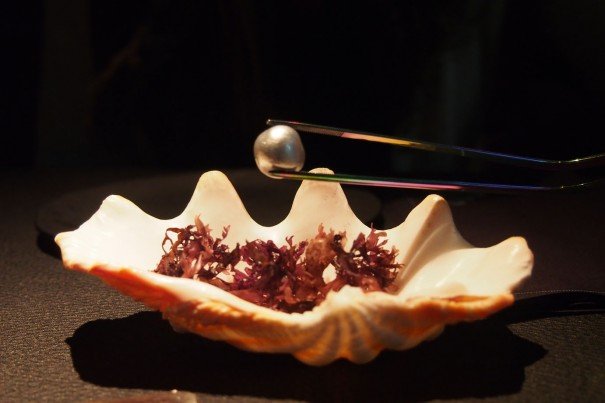
Of course, this is what also makes this style of food controversial. Some people want their walnuts to taste like walnuts, their caviar to taste like fish eggs, their beans to be real beans and not made from concentrated bean essence encased in a thin membrane of bean juice solidified in a bath of sodium alginate. Indeed, there were moments in an El Bulli marathon where the only response you could muster was, “Why?” And cheap imitations around the world—often from young chefs who haven’t learned how to properly braise a piece of meat but nevertheless feel compelled to break out the hydrocolloid kits—have somewhat diluted the Adrià brand of blowing minds. But at its best, there is no food more provocative and generous and challenging—and even the disagreements and criticisms and doubts that ring out from many corners of the culinary world prove what Albert and Ferran have, deep down, always wanted people to believe: that eating with them is as much an art experience as it is a food experience. (To wit: When 41 Degrees changed from bar to restaurant, the name changed, too. Now, officially, it is called 41 Degrees Experience.)
There are no knives and forks at 41 Degrees. No plates either, really. Most dishes—none more than a few bites big—arrive perched on rocks, resting on leaves, suspended from trees. The first 15 or so are snacks, and they come out firing: a cloud of caramelized raspberry meringue dusted with wasabi, crispy seaweed dotted with puffed quinoa, the famous air baguette, a crisp shell of bread sheathed in jamón iberico that has been aged for five years, an impossibly long cure that turns the protein into a sheen of umami and the fat into some type of sacred lipstick.
Owing to the space’s first life as a cocktail bar, and to the long tradition of snacks-and-cocktails as an opening salvo at El Bulli, high-concept libations pepper the meal like exclamation points: shochu with yuzu and wisps of shiso smoke, a pisco sour made with celery and apple, a semi-solid margarita shot with a single shard of sea salt that slides off an avocado leaf and into your mouth. Wine would be a tough match for most of these dishes, but cocktails like this can stand up to the force of this food.

The second part of the meal is called Journeys, and as the name implies, dinner soon unfolds as a series of passport stamps. The Adrià brothers were among the first to tap into the pantries of the world—incorporating flavors of the Far East, Mexico and Peru into El Bulli menus years before the rest of the world followed suit—but this represents a more measured, deliberate attempt to tackle the world’s grand cuisines. While in Russia, you’ll eat smoked eggplant bathed in pearls of fish and hazelnut caviar (false caviar, made the same way the olives are, is an Albert obsession). In Japan, lobes of sea urchin meet cubes of roasted sweet potato, the brine and the sweetness set of by little depth charges of mandarin gelatin. A trip to the streets of Saigon delivers the best bahn mi you will ever eat, a two-bite sandwich made with bread fried to a puffy crisp in olive oil, then stuffed with tender chunks of suckling pig rubbed with lemongrass and fish sauce. The Nordic plate may be an homage to Noma, but considering the quality of the two bites—carrots covered in a candied beet shell covered in crème fraiche, a rye crisp paved with raw Kobe beef and dotted with pickled onions and smoked cheese—it could easily be construed as a challenge to the Danish throne.
In lesser hands, all of this would feel like a parlor trick, a dash to the food court or a stroll through the concession stands of Epcot Center, but with Adrià and his able-bodied crew, every far-flung bite feels well earned. Baked into the meal are interviewing narratives about the origins of food, about time and place, about the mutability of it all in this modern age. Combined with the smoking cocktails, the glittering art installation, the carefully chosen music, the little moments beyond the bites themselves that push and pull on your emotions, you come to realize that 41 Degrees isn’t dinner; it’s theater.
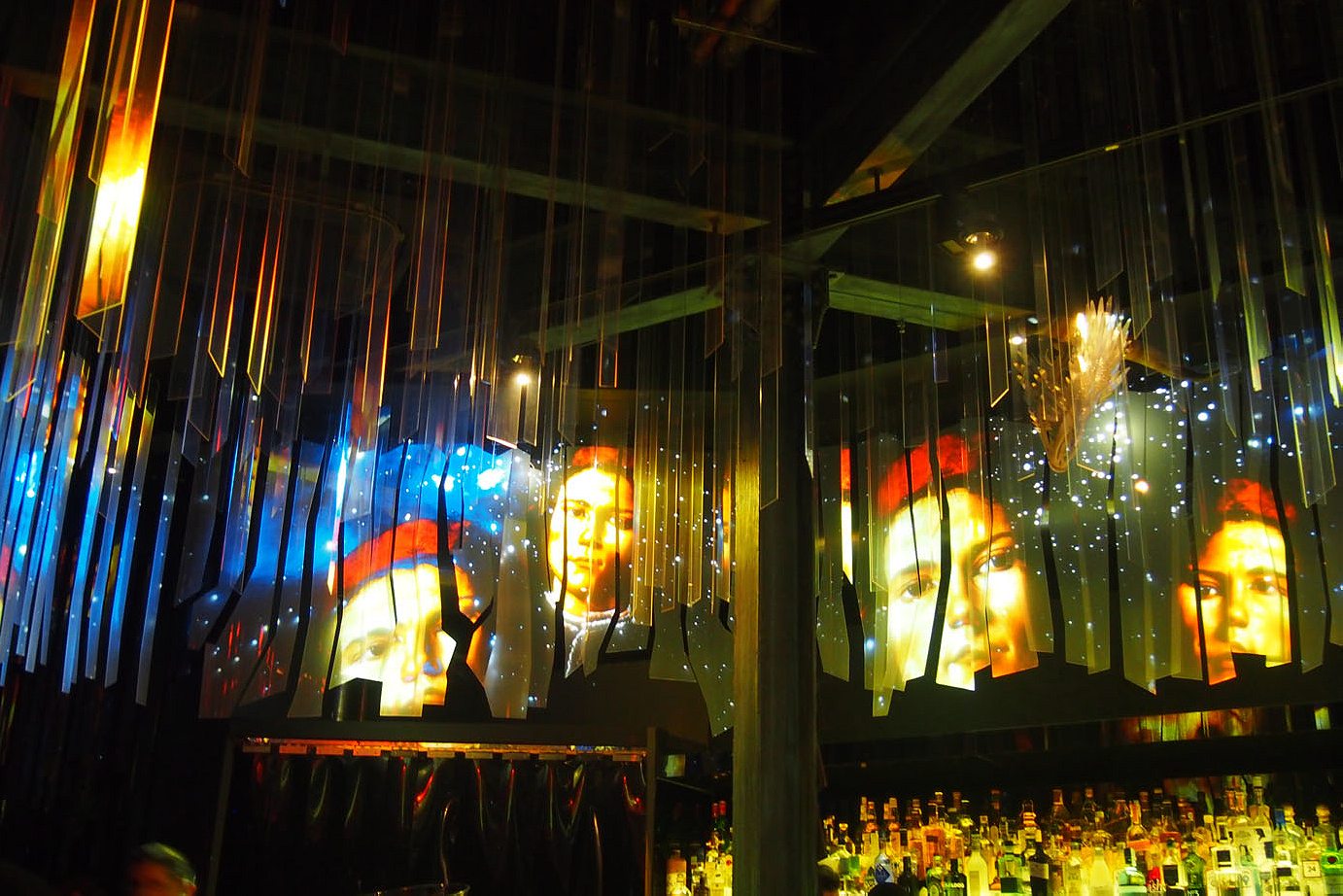
When you eat a meal like the one served at 41 Degrees, when you tally up all the dishes and run through all the components, when you count all the ingredients and calculate the type of technical mastery and scientific precision that went into it all, you imagine that beyond those swinging doors lies a sprawling kitchen laboratory where beakers and Bunsen burners chase perfection down like an asymptote.
When I visit the kitchen a few days later, the reality is considerably more, well, romantic. It’s 7:45 pm, not long after the first round of snacks and cocktails have gone out to the evening’s guests, and the cooks are gathered around a makeshift charcoal grill. Everyone seems genuinely pleased with the set up, which along with the 4-burner stovetop, the tiny flattop and the small convection burner in the back, leaves them with fewer heat sources than you’d find in the average tapas bar on Las Ramblas. In total, the kitchen is approximately the size and shape of a moderately wealthy woman’s closest.
One of the cooks breaks up the party as he wedges his way in to knife a few sweet potatoes buried in the coals—the same way one might do around a campfire in the woods. “I think they’re almost ready.”
In the corner, a skinny chef with his name scrawled on his whites pays no attention to the line cooks. Sebastián Mazzola is up to his own MacGyver tactics. He takes what looks like an oversize vaporizer, pours eucalyptus oil into the base, switches on the motor, and brings down the tube to cover a tray of micro sprouts. He fiddles and fusses with the delivery system, trying to find ways to concentrate the smoke buildup, and 20 minutes later, he’s laying the cold-smoked sprouts over an oil-poached Jerusalem artichoke painted black with a puree of truffle and huitlacoche, a Mexican corn fungus. He’s been working on this dish every afternoon this week. He takes a bite and rolls it around in his mouth like a good wine. “We’re getting closer.”
As much as the dining public wants to believe that the chef with his or her name on the door seared their pork loin and came up with that genius tweak on their tiramisu, there is always a team behind the chef, and when the team is as big as Albert’s, there is always a chef behind the team—the hand that guides, the mouth that tastes, the eye that watches. Sebastian, 29, Argentine, creative director of the Adrià organization, is that chef.
“Sebastián has the same importance for me as I had for my brother. Ferran was once Guardiola and I was Messi,” says Albert, reverting to the age-old Catalan tradition of using the FC Barcelona soccer team as metaphor for everything in life. “Now he is my Messi. Everything goes through him.”
He is my Messi. Everything goes through him
Sebastián’s path to the top of the food chain doesn’t look like most young chefs’: he didn’t spend years at an upscale culinary school, he didn’t systematically work his way through the Michelin temples of Europe. At 14, he manned the grill at his grandma’s restaurant in Buenos Aires. He cooked road kill for truckers in Patagonia. He was the drummer and cook for a roving band, a gypsy circus that scraped their way through Peru and Bolivia on loose change and rotting produce. He took on more formal gigs, too: roasting prime rib for Americans at a private club in Florida, pureeing borscht for Poles in Buenos Aires, stuffing pasta for wealthy Mexicans in Playa del Carmen. Finally, in 2007, he washed up on the shores of Cala Monjoi, home of El Bulli, and eventually fell into Albert’s sphere. After bouncing around Barcelona in the post-Bulli days, he ended up at Tickets.
“He had never worked here and now he’s the boss,” says Albert. “It’s animal law. The macho lion comes with all his hair and the rest shut up because he’s shown he’s the macho and he deserves respect. That’s Sebas.”
People talk about Sebastián now the way people used to talk about Albert—hell, the way some people still talk about Albert. “He’s probably the greatest cook I’ve ever known,” says Kaya Jacobs, former sous chef at 41 Degrees, who now runs his own restaurant in Barcelona’s Gracia neighborhood. “Albert saw that right away and said ‘okay, you’re no longer working for the restaurant, you’re working for me.’ In 5 years, he’ll be famous.”
You see a lot of Albert in Sebastián: he’s animated and insatiable, with a wild streak and an enormous intellect. Above all, he’s a hyper-talented amorphous cook, as comfortable working pastry as grilling caveman steaks as cold-smoking sprouts with a vaporizer. To create a universe as complex and far-reaching as that which Albert intends to build, you need a Sebastián Mazzola.
Back in the kitchen at 41 Degrees, the Journeys part of dinner is underway. Russia goes out the door; Japan is on deck. Juan Carlos Iglesias, one of three Iglesias brothers who are partners with Adrià in all of his new ventures, pops his head in to salute the team. He sees Sebastián working on his latest dish and beams like a proud padre.
“These guys have created and cataloged over 300 recipes in one year in this space. In this fucking space! All of the best kitchens in Spain combined haven’t created that many. These guys are wild animals.”
It sounds a bit like the bravado of a man with a nest egg invested in the restaurant, but when he pulls me aside periodically throughout the night to reiterate his belief in this enterprise, his body literally shaking with conviction, it’s hard not to take him seriously.
Shortly after, Albert walks in. Without saying a word, he settles beside one of the young line cooks and sticks out his hand. The cook grabs a squeeze bottle and deposits a dollop of sauce right at the base of Albert’s thumb. He grabs another bottle and does the same. Albert, tasting both, seems satisfied and eventually moves on. The whole room relaxes a bit, save for Sebastian, who barely noticed his boss standing over his shoulder as he peeled Jerusalem artichokes.
Later, when I talk with Sebastian, he is careful about how he describes their ambitions. “Yes, we’ve created a ton of dishes and this team can do just about anything, but this isn’t El Bulli. We’re not trying to invent new techniques, not yet at least. We just don’t have the space for it.”
Of course, Albert’s working on that, too. He plans to move the entire 41 Degrees operation down the road to a larger space, where they can feed more people and have kitchen space dedicated solely for R&D. There they could incubate ideas and push cooking in a new direction, but for now, until a new lease is worked out, it’s a mixture of careful conception and surgical precision, not boundless innovation, that defines dinner at the restaurant.
For the diners, that may not be such a bad thing. What they are experiencing right now is the best of the El Bulli techniques combined with the best of Albert and Sebastian’s imaginations. Technical maneuvers, like the olive spheres or a new method they use to dehydrate soy sauce into edible sheets, intensify rather than obfuscate flavor, and taste never labors under the weight of the next interesting technique. When I ate at El Bulli, I found I didn’t like 25 percent of the dishes (still, an admirable ratio for a restaurant that hit the type of unthinkable high notes that El Bulli did). Of 46 plates at 41 Degrees, a handful are timid or meandering or a touch too abstract, but there are precisely zero duds in the entire meal.
And yet somehow, even with Albert’s reputation, Ferran’s blessing, and the staggering talent filling up its tiny kitchen, 41 Degrees has gotten relatively little love from the international press. During its last year in operation, El Bulli received nearly 8 million reservation requests for just 10,000 seats. As I type this, you can still book a table at 41˚ next week.
Maybe this is just an anomaly, a rare case of word traveling slowly as 41 Degrees settles into its role as a restaurant with huge aspirations. Or maybe there’s another explanation: Has the withered economy threatened the 200 Euro dinner? Has the post-Bulli public soured on the dinner table pyrotechnics? Do people just want their food to be food and that’s it? What’s clear is that these are high stakes here in Barcelona, not just for Albert, but for an entire generation of chefs wondering just how far they can bend the dining experience until it breaks.
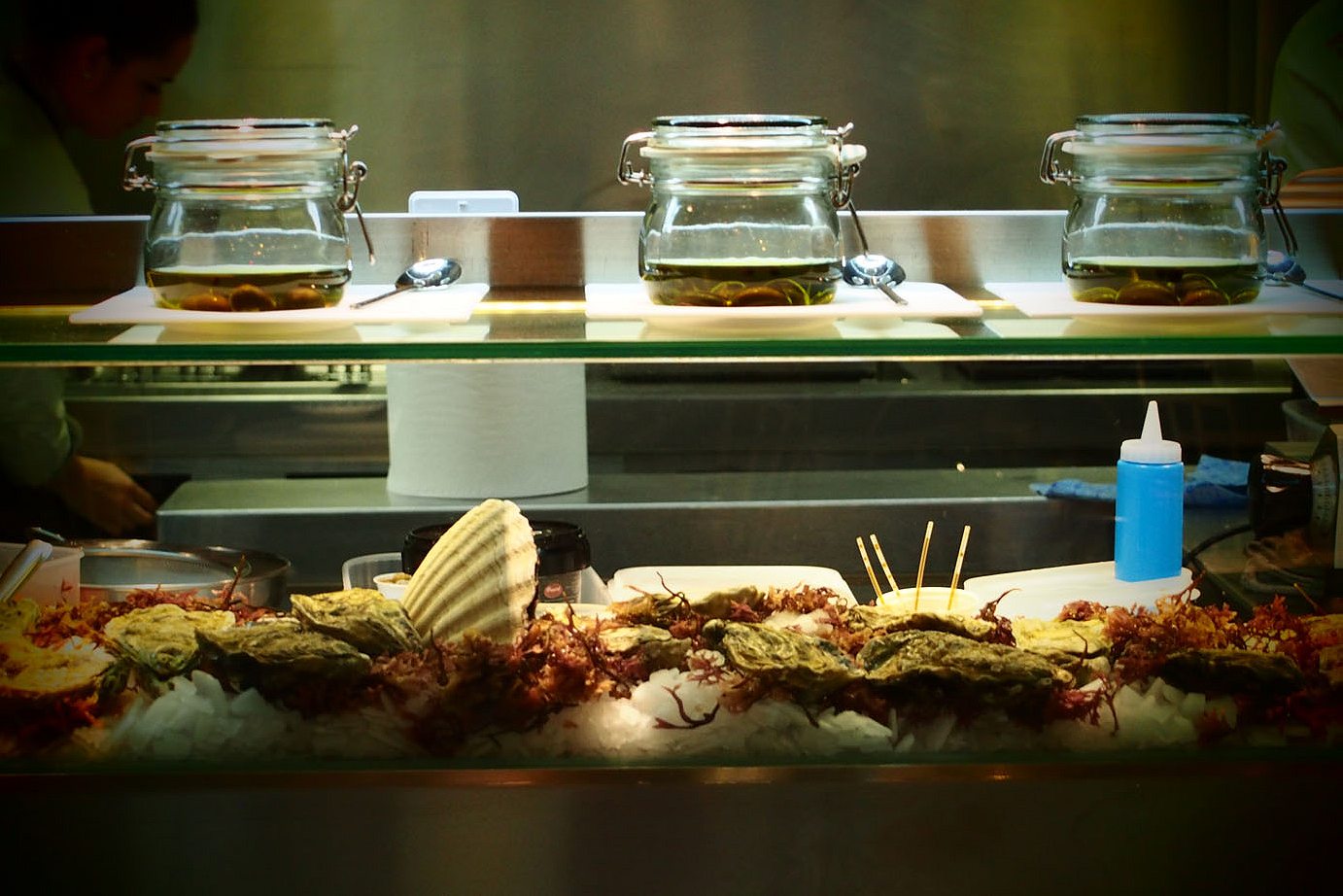
To walk through Tickets, the tapas emporium that serves as the nerve center of the Adrià enterprise, is to step into the mind of Albert. The space is divided into distinct environments: a raw section with a smooth ivory bar and broken tile floors, a modern tapas bar with a screen showing footage of some of El Bulli’s most famous techniques, a dessert area made to look like a carnival, complete with a red and white circus tent and cotton candy trees. A stock ticker announces the restaurant like a summer premiere, and everywhere you turn, golden Chinese money cats paw at the air menacingly. The restaurant is loud and bright and utterly confounding in that it somehow achieves the feeling of being both meticulously curated and totally unharnessed at the same time.
Albert doesn’t have an office, so when he has work to do, he takes a corner table at the restaurant, fills it with books and folders and loose scraps of paper, and opens up his laptop.
This afternoon he’s tackling the business of the forthcoming Tickets book, which demands a good amount of writing from its fearless leader.
“Are you serious? You mean to tell me there’s really no information about razor clams on Wikipedia?”
Across the various corners of the restaurant you’ll find the capos in his crew working through their own individual problems. Kioko Li, the Japanese chef at Pakta, is in the kitchen, playing around with different nigiri preparations. Jorge Muñoz, the Peruvian part of the two-headed Pakta dragon, is over by the modern tapas bar, talking to suppliers about pisco. Paco Mendez, the chef from Mexico in charge of getting Yaguarcan open by this summer, is grooming the menu, trying to find a way to fit the entire eating experience of Mexico into a three-story restaurant on a small side street in Barcelona.
To watch how a dish is created in this system, you need only pull up a seat at the bar in Tickets in the middle of the day and wait. Usually, it starts like a vibration in the corner of the room, as Albert, planted at his table, begins to shuffle papers. Eventually his voice grows as he calls out the seedling of an idea. If he’s really excited, he’ll jump up and go directly to the person, often walking all the way across Tickets and down the little corridor connecting the restaurant to 41 Degrees to find Sebastián.
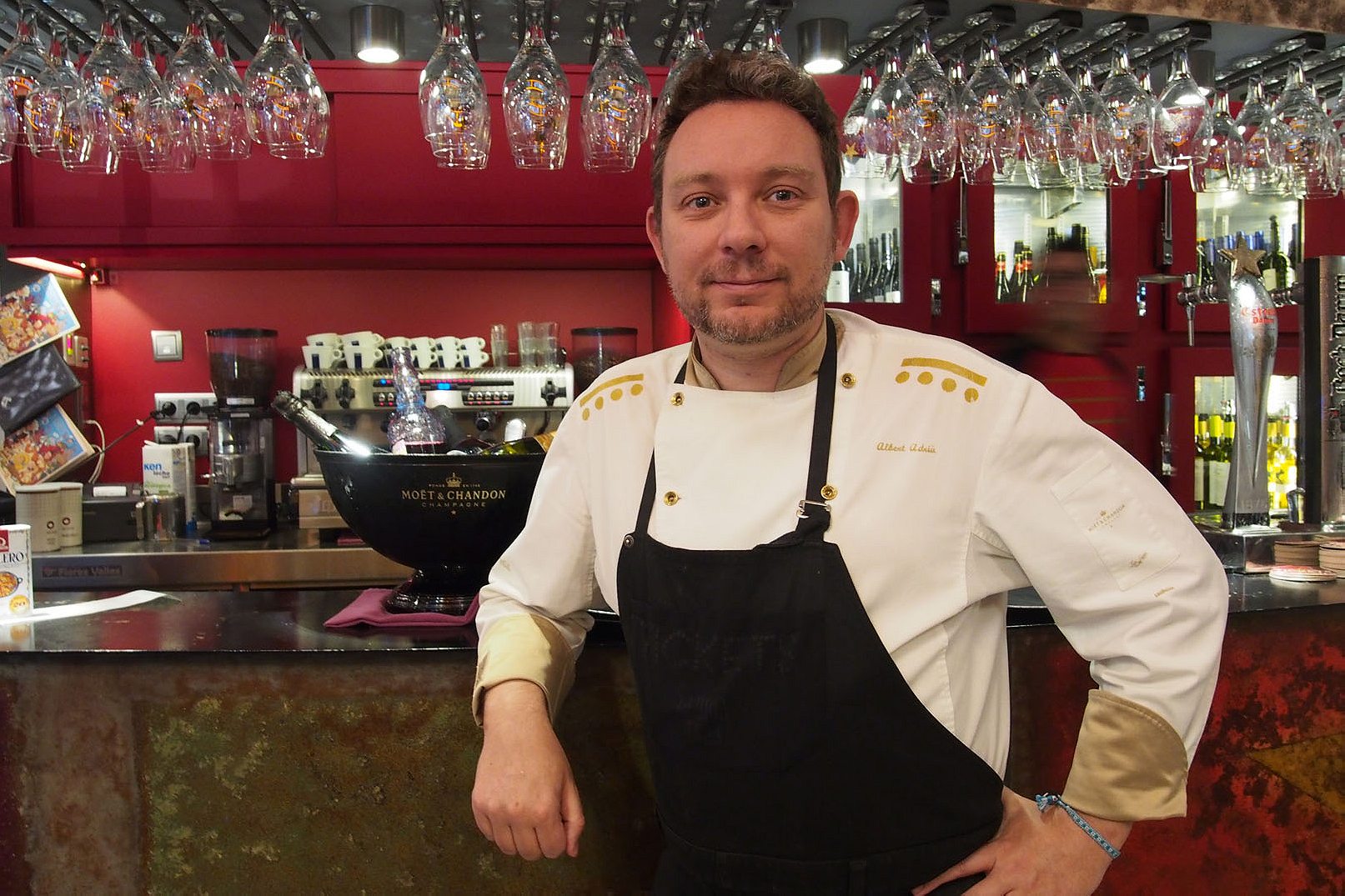
This first stage is the genesis: Albert likes to say that he’s a better creator than a cook, but his brand of creativity requires interpreters, people like Sebastián who are uniquely skilled at metabolizing the vagaries of an idea and turning them into meat and bones. Later comes the editing, the constant tasting and refining that sharpens the edges of a blurry idea until they can break skin. In this way, he keeps his hand in every pot, makes sure that every piece of food—whether a pork taco, a foie gras nigiri, or a ten-component modernist masterpiece—tastes like what the world has come to expect of an Adrià.
Spring is coming and today Albert has peas on his mind; he finds Sebastián and gives him the basic sketch. “I’m thinking Maresme peas with wasabi and some touch of rose.”
Sebastián looks skeptical, but he knows all too well that Albert’s strangest ideas can often be his best. So he goes to work, first making a pea stock with the pea pods, but he wanted more flavor and color, so he eventually combines the stock with pea juice: perfect. The wasabi pairs nicely with the sweetness of the peas, but it’s missing texture; Sebastián and one of the 41 Degree cooks talk and he comes up with this: raw lychee fruit, cut in strips to look like pieces of squid (of course!). As for the rose? That comes last, the petals turned into an aire, a featherweight foam used to crown the dish at the last second.
The process takes days of testing and refining to complete, but at the end, they have a new dish to run in the early spring at 41 Degrees. “None of it really makes sense conceptually, but it came out incredible.”
“I have a huge mental palate that I draw from. I can visualize how something will taste before it’s been cooked,” says Albert. “But I don’t cook now. I say how it should be done and I taste. It’s better the rest of them cook, in the kitchen with my hand, like Remy from Ratatouille.”
In this way, they’ve created more than 500 dishes between Tickets, 41 Degrees and Pakta over the past year. 41 Degrees dishes are the most labor-intensive (there are 17 employees for just 16 nightly diners, after all), but Pakta, being the newest restaurant in the mix, requires the bulk of time and attention, with most of Albert’s top team members dedicated to bringing the Japanese-Peruvian experiment to life.
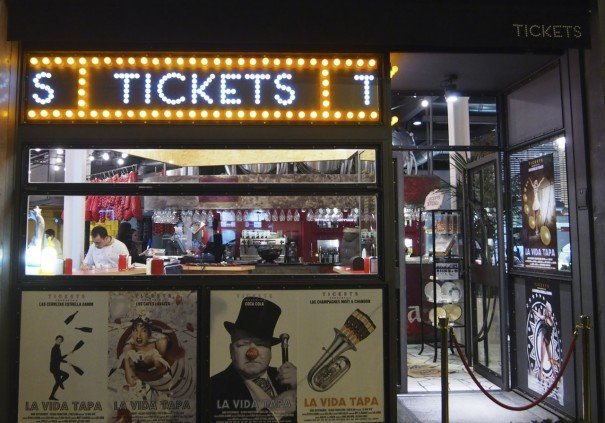
At just over two years old, Tickets is the big brother of the group, a mature and confident restaurant that knows exactly what it is. It wasn’t always this way; my first few meals at Tickets a few years back were awkward and underwhelming. Like the setting itself, it tried too hard to be all things to all people.
Albert always said he wanted to find the middle ground between a traditional tapas bar and El Bulli, and judging by two recent dinners, he finally occupies that zip code. In terms of pure flavor, few restaurants can touch this type of cooking: sheets of marbled tuna painted with melted jamón fat that rival the greatest sushi creations of Tokyo, a tomato tartar somehow more meaty than versions made with beef, a piece of fish fried so beautifully that it literally made me well up.
You get the feeling that no matter what happens in the years ahead, that Tickets will be home for Albert, the place where he feels most comfortable, the doppelganger for his many mysterious facets. The restaurant remains the toughest reservation in Spain, overflowing with a funky mix of foreigners and locals living la vida tapa. Behind the trees of cotton candy, the smoke of liquid nitrogen, the ringing bells of a rolling ice cream cart and the din of plates being scraped clean by a room full of happy diners, there’s Albert, a Willy Wonka for overgrown kids.
Mar y Montaña at Tickets from Roads and Kingdoms on Vimeo.
Even before El Bulli officially closed, the international press began the predictable search for its successor, the chef and the restaurant that would lead the culinary world through dark times and into a new age of deliciousness. Many looked to the north, where Mugaritz chieftain Andoni Aduriz mixes Spanish modernist technique with a certain type of Nordic naturalism to create an idiosyncratic brand of avant-garde cooking. Or to the south, to the coastal down of Denia, home to Quique Dacosta, a big-thinking chef with an alchemical touch with seafood and vegetables and rice. Or to El Bulli’s neighbor, El Celler de Can Roca, currently second behind only Noma on San Pellegrino’s 50 Best Restaurants in the World list, where the three Roca brothers conspire to create a dining experience that is at turns shocking, refined, classic, and deeply moving.
But few mentioned the most obvious heir to the throne, the guy who helped build the kingdom in the first place. As of today, Albert possesses no Michelin stars, has no restaurant on any of the big lists of global favorites. But he says he’s not worried. “My restaurants are full and my diners are happy. Besides, these days, a comment on Trip Advisor or a blog or the rumblings of the press matter more to a restaurant than Michelin.”
It’s hard to imagine, though, that deep down, it’s not about more than just making people happy. After all, people are plenty happy at Tickets. So why 41 Degrees? And why Pakta? And why everything else so fast?
“Because one day I’ll wake up and I’ll no longer want to do anything.” Reasonable enough, but it’s one of three or four different answers he gives to the same question, as if he’s probing the surface for a soft spot.
After all, this is a man who began to change the culinary world before he could legally drive. This is a man who cracked more kitchen codes than any cook that came before him. This is the man who turned solids into air, liquids into caviar, sesame into humming birds. This is a man who spent 25 years working beside his brother, a cook who casts a shadow so large that even to this day, the restaurants that Albert has worked disgustingly hard to create from scratch are still referred to as “Ferran Adrià’s new restaurant” in headlines around the world.
So I try a different question, and I ask it to both Ferran and Albert on separate occasions: Is it hard being the brother of Ferran Adrià?
“No.”
Both answers come so fast and forcefully they feel like an echo.
Ferran is no longer in the kitchen with Albert. Though he is technically a partner on all of these new ventures, he’s no longer driving the machine. “At El Bulli, I was the ying and Albert was the yang. Now, I am the yang and Albert is the ying ying ying.” Ferran’s yang services mostly amount to brotherly council and professional feedback on the food. He may not put in work in the kitchen, but he spends plenty of time in Albert’s dining rooms.
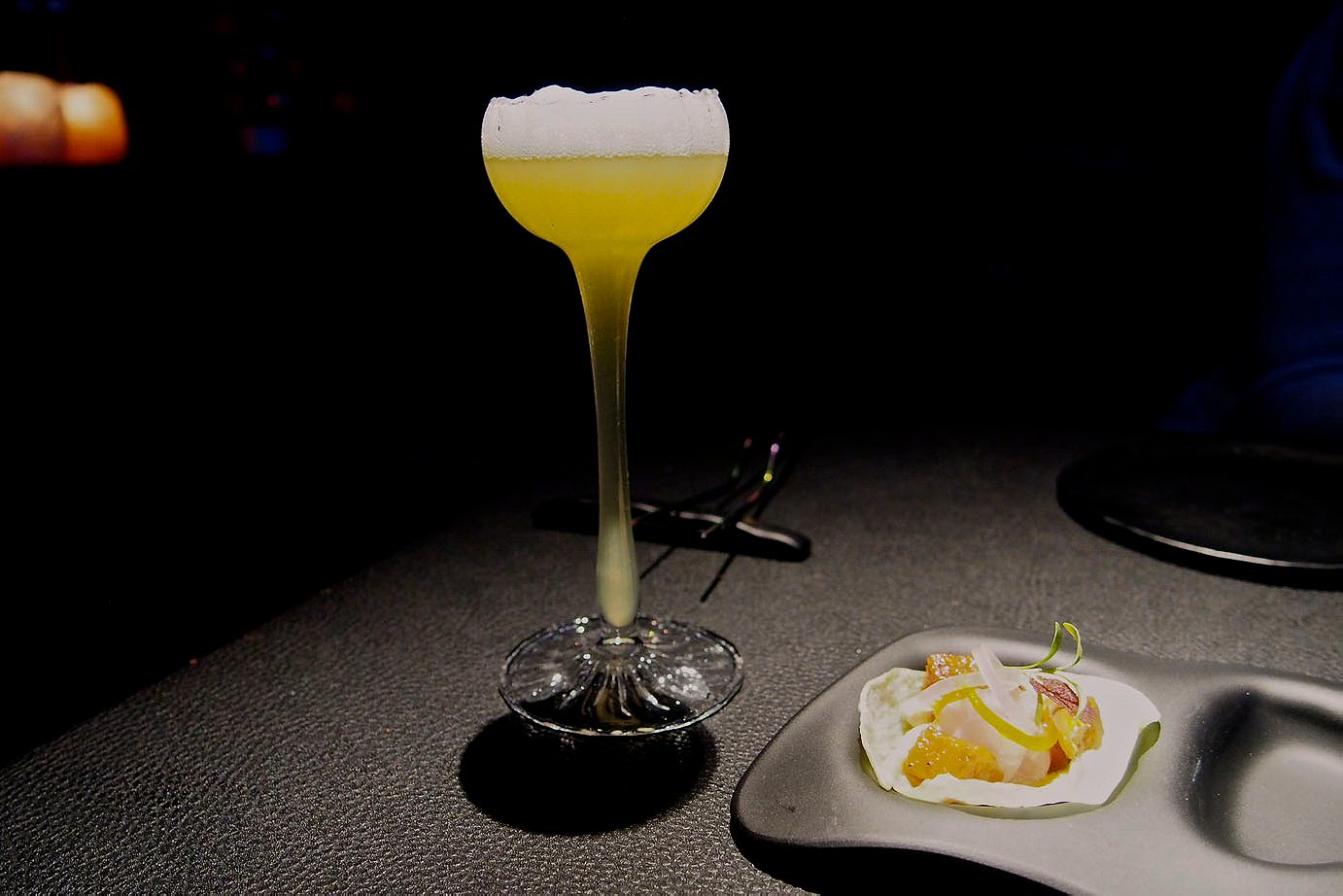
When I finally make it to Pakta, it’s well past midnight and there is only one table left lingering over drinks and desserts. This the last night of trials, where Albert and his team run through the new menu for a group of close friends, families and local dining royalty.
Ferran has been in every night the past two weeks, and he’s offered plenty of feedback. The Spanish press has been in, too, along with a handful of big names here and there. Tonight’s last guests certainly qualify: Joan Laporta, the former president of FC Barça, Xavier Sala i Martín, a famous Catalan economist, and, at the head of the six-top, Pep Guardiola, former coach of FC Barça and patron saint of Catalan soccer lovers everywhere. (In the many mixed metaphors of Albert’s life, his brother was once Guardiola and now he is, so what does that make the real Pep?)
Albert bounces in and out of the conversation, putting his hand on Guardiola’s shoulder with an ease that few men anywhere can claim.
A round of pisco sours arrive with a thick egg white cap speckled with Angosturra bitters. Then a scoop of dulce de leche ice cream spotted with cocoa nibs and a glass jar of passion fruit meringues.
Sebastián sits down at the bar next to me, tired but clearly buzzing. “Service was incredible.”
Finally, Albert comes over and takes a seat. “It’s amazing what we’ve done in the past two weeks. You wouldn’t believe it.”
It’s clear that both of these men live for this moment, when they can look at the space and the menu and the team behind them and see a hundred different realities sparkling before them. It’s also clear that neither of them will be happy when the menu is fully set and the Pakta team is on cruise control. Yaguarcan will be next, then, in theory, the big 41 Degrees move, then a vermouth bar. Then, who knows.
After years of talking and planning, months of testing dishes, and a few weeks of live trials with friends, family and dignitaries, Pakta is ready to open to the public in 10 days. First, though, comes Holy Week, when all of Spain grinds to a halt.
Sebastián is headed to Sicily. He wants to eat sardines and pistachios and find a grandma who will teach him how to cook Sicilian pastas.
Albert will spend the week on the Canary Islands, the last breath before the big storm.
“My friend has a place in Tenerife. Amazing spot with a pool. I’ll have my computer and my books. Can’t wait. Time moves slow down there. It’s like every minute feels like an hour.”